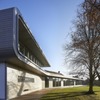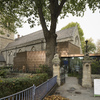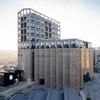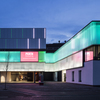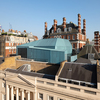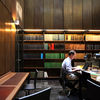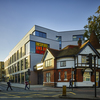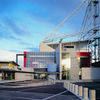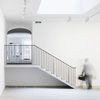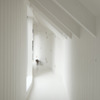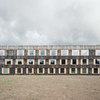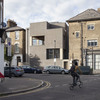Juergen Teller Studio
Subscribe now to instantly view this image
Subscribe to the Architects’ Journal (AJ) for instant access to the AJ Buildings Library, an online database of nearly 2,000 exemplar buildings in photographs, plans, elevations and details.
Already a subscriber? Sign in
The structure is entirely concrete
Johan Dehlin Download Original
A photography studio with an entirely concrete structure makes the most of light and space.
The studio, for photographer Juergen Teller, lies just north of London’s Westway. The façade is folded slightly down the middle, and a huge window bursts through at the top left. The entrance is a garage door-sized aperture filled with light grey wood, which opens to reveal an enfilade of alternating darkness and light receding into the back of the building, through its three volumes and two courtyards.
Indeed, the entire structure is of concrete, with the exterior walls poured in situ, as were the large fine beams. The rest is of blockwork.
The ground floor of the front pavilion houses a heavily protected store for Teller’s archive. Further along the corridor a shaft of illumination falls from a skylight. Looking up, one is presented with a view of a lightwell half-filled with a steel grille floor.
Beyond this, a stairway – glazed and equipped with brass railings – takes the visitor up to the main office, that space behind the large window facing onto the street, as well as smaller offices that were originally intended to house photo-processing facilities.
Outdoor spaces have been planted by garden designer Dan Pearson with the kind of flora that erupted from the ruins of London after the Blitz. The ground is of shattered concrete, cast here and then broken up with a pneumatic drill to make spaces for plants. Beyond this courtyard, through a glazed lower storey, is the second pavilion. This is entirely occupied by the main studio, a large warehouse-like space top-lit through concrete beams. The room is bookended by two ‘superbeams’, suspended storage spaces that are accessed by narrow staircases.
Finally, beyond another courtyard lies the last pavilion, which contains a dining room, a library and above these another, unprogrammed room.
The extreme depth and narrowness of the site not only directed much of the design, it determined the way to build it. Primary structure and external walls are reinforced concrete cast in-situ. The building is highly insulated and lined in a combination of concrete and blockwork to maximise thermal mass and natural material textures. No finishes are applied, not even paint. Construction, which could only be accessed from within the site, had to proceed laboriously from the rear towards the street, casting one building at a time.
Data
- Begun: Apr 2014
- Completed: Mar 2016
- Floor area: 513m2
- Sector: Arts and culture
- Procurement: Design and Build
- CO2 Emissions: 36kg/m2/year
- Address: Latimer Road, London, W10 6QN, United Kingdom
Professional Team 
- Architect: 6a architects
- Project architect: Tom Emerson
- Client: Juergen Teller
- Landscape architect: Dan Pearson Studio
- Structural engineer: Price & Myers
- M&E consultant: Max Fordham
- Quantity surveyor/cost consultant: Gleeds
- Client representative: AECOM
- CDM co-ordinator and approved building inspector: MLM
- Main contractor: Harris Calnan
- CAD software used: Bentley Microstation
























